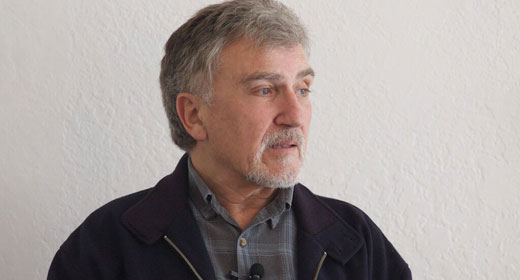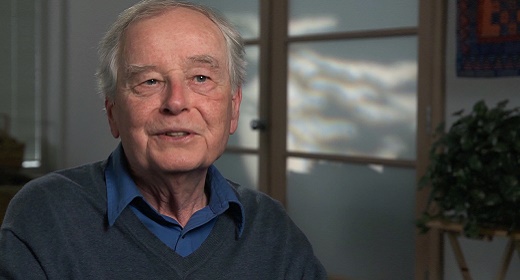By Dan Charnas: If I could teach only one yoga exercise—one that had to last you for the rest of your life—it would have to be Sat Kriya. Why?

Because this one exercise contains just about all the benefits of Kundalini Yoga within itself. Sat Kriya is designed to do the one thing from which all well-being springs: raise the kundalini energy.
Here is simple and effective Sat Kriya. It is by no means the last word on Sat Kriya; but beyond words, it works.
Preparation:
1) Sit on your heels in Rock Pose (Vajrasana).
(Alternate: Rock Pose is the preferred posture but if you are unable to sit in Rock Pose, you may sit in Easy Pose.)
2) Stretch your arms above your head so that they are perfectly straight, no bend in the elbows, upper arms hugging your ears.
3) Interlace your fingers and extend your index fingers, pointing upward.
(Advanced students: If you’re not a drinker or smoker and have never taken drugs, you may try extending all the fingers and placing the palms flat against each other.)
4) Close the eyes and roll them up to the Brow Point.
5) Inhale slightly to begin.
The Exercise:
1) Powerfully chant Sat,[1] squeezing the navel back towards the spine.
2) Chant Nam as you relax and release the belly (breath will come naturally).
3) Repeat: Squeezing the navel in on Sat; releasing on Nam. Squeeze, release. Squeeze, release. Keep going at a moderate pace.
A Note about the Breath:
One perennial question I get from frustrated students is, “When do I inhale?” The answer is, let it come naturally for you within the rhythm of “squeeze-release.” Don’t get too hung up on this. This is not a deep breathing exercise. Let the breath come naturally. You’re creating a powerful experience that’s natural for you.
To Finish:
1) Inhale deeply and, with the breath held in, squeeze the Root Lock. Draw the energy up your spine to the top of your head and even to the tips of your fingers. Hold about 8 to 10 seconds. Exhale.
2) Repeat: Inhale deeply, hold, squeeze, then exhale.
3) Inhale deeply and then exhale completely out, apply the Root Lock and also the Neck Lock. Hold a few seconds and then release everything.
4) Lie down on your back in Corpse Pose (arms at sides, palms facing up). Deeply relax for the same amount of time that you did the exercise.
Times:
One minute is good for beginners to get the hang of things. Three minutes is a good starting point for regular practice. Gradually work up to 7, 11, 22, or 31 minutes in one sitting. By the time you reach 31 minutes, you’re in self-mastery territory! And some lucky folks do Sat Kriya for 62 minutes!
Don’ts:
- Don’t let the arms fall or the elbows bend. Keep stretching up and if you feel yourself fading, keep recommitting to the exercise. Stretch up from your armpits.
- Don’t let your chest, shoulders, and arms move up-and-down as you chant. This isn’t aerobics. The motion is simply the squeezing of the organs “below the belt.” Keep the upper body nice and stable.
How it Works and What it Does:
The continuous “squeeze-release” motion creates a powerful pump for your kundalini energy. On the physical level, when Sat Kriya is properly done, this release gives your body the energy it needs to heal and regenerate every organ and cell. The energetic level, though, is where Sat Kriya really performs.
Sat Kriya works primarily on the lower triangle—the first, second, and third chakras. The lower triangle corresponds to the earliest stages of our human development, with the first chakra especially relating to birth, infancy, and the issues of fundamental security, being-ness, and belonging. Sat Kriya, in working on the lower triangle, has the power to excavate deeply entrenched wounds from our early life. That’s why it’s often recommended for healing mental and psychological imbalances. I like to think that Sat Kriya is probably the best way to heal the psychic residue of inadequate parenting and severe childhood wounds. That’s how deep it goes!
Sat Kriya doesn’t have to be the only Kundalini Yoga exercise you’ll ever do, but if you make it a part of your daily practice, you’re well on your way to being healthy, happy, and whole.
Dan Charnas is a journalist, screenwriter, record producer, and teacher. He writes about culture, race, and politics for a number of publications including the Washington Post and the New York Press. His new book, “The Big Payback: The History of the Business of Hip-Hop,” is a 40-year narrative of the executives, entrepreneurs, hustlers and handlers who turned rap music into the world’s predominant pop culture. Dan has been a teacher of Kundalini Yoga for nearly a decade, certified by the Kundalini Research Institute. He teaches regular classes in New York, and contributes regularly to YogaJournal.com.
Source: 3HO









































